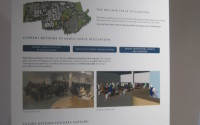Motorcycle Module 1 test
Things have been a bit quiet round here this month for one reason or another. The biggest reason is my research focus this month shifted slightly away from software development and into report writing. It started with my end of year report is due in with the university in January which needed drafting for supervisors to approve before moving onto a research paper I submitted in September being accepted for journal publication pending some revisions, so the latter half of this month has been concentrating on those revisions, and continuing to draft another paper on research I conducted just before and after my trip to India. So not a lot in software development this month means not many posts about things that might be helpful, so I decided to write about my experience doing the module 1 motorcycle test (in the UK) which may be of use to other learner motorcyclist embarking on the module 1 test.
Background to biking
Just briefly, I began my motorcyclist stage in July 2014 when I completed my CBT in Bath. The main drive for this was the commute from home to the office (in Bath) every day which, in the car, could take 1.5 to 2 hours depending on the traffic. I therefore sought an easier alternative in the form of a motorcycle so completed the CBT (Compulsory Basic Training) and then bought a Yamaha YBR125 to begin on in the August, which is my current bike. I rode this into the winter (wanting to get experience with the bike/riding before doing any test), by which time it was too cold (at the time, for an inexperienced rider) to take any tests, so I held out to get winter experience. Then came spring and I was recalled to university 2 days a week for lectures, which restricted the amount of time I had in the office, so I couldn’t do anything about the test then. In July 2015 I finally managed to take and pass my motorcycle theory test (which itself is practically the same as the car test I took 6 years ago) and began looking at getting a full motorcycle licence. That was when I found this document on the UK Government website explaining what sort of licence I could get at that time. Due to my age, I would have been on a restricted licence (if I took/passed the practical tests before I turned 24) and to upgrade to unrestricted would have required me to take another 2 practical tests (at more expense!). So, with only a few months until I turned 24, I opted to wait and take the tests now for a full unrestricted licence from the outset. Which brings me back to module 1.
What does the test include?
The module 1 test is the off-road manoeuvres portion of the test and includes three distinct parts – manual handling, slow speed control, and high speed control. There are 8 things you have to complete to pass the test and demonstrate to the examiner that you are competent at handling a motorbike in various situations. The 8 things are:
- Manual handling of the bike – moving the bike without the engine running between parking bays
- Slalom – a slow speed slalom through a set of cones
- Figure of 8 – a slow speed figure of 8 around two cones (you have to complete 2 of these)
- Slow ride – a slow speed controlled ride as if moving in slow moving traffic, coming to a controlled stop
- U-Turn – a turn in the road between the white lines
- Controlled stop – a high speed ride round a bend, through some cones and then coming to a controlled stop at the end of the straight
- Emergency stop – a high speed ride round a bend, through some cones and completing an emergency stop (in a controlled manner)
- Hazard avoidance – a high speed ride round a bend, through some cones and then a swerve to avoid a cone before coming to a controlled stop
Things to be aware of
For the last 2 components (emergency stop and hazard avoidance) there is a minimum speed requirement you must achieve in order to complete the exercise. Below this speed and you will fail the exercise (and the test). The speeds vary depending on the machine, but for an unrestricted licence I had to complete these exercises at 50kph (approx. 32mph) or above. You can go faster than the 50kph – you’re just making it harder to stop after the speed trap though. But going under is not acceptable. The purpose of these exercises (along with the slow speed ones) are to show the examiner you can control the bike in both low speed and high speed situations.
Putting your foot down during the low speed components will count as a fail, so make sure you practice the slipping clutch control (using the rear-brake to control the speed of the bike – you should be taught this at CBT) to ensure you can move along slowly without feeling the need to balance with a foot. I rode through the slalom, figure of 8 and slow ride between 3-5mph (on the bikes speedometer) and this was acceptable for a pass.
Observations
The examiner will ask you to treat the off-road test pad as if it were a public road. While you won’t encounter traffic (usually the pads are fenced off areas), you should be doing all of your normal observations. That includes shoulder checks (left and right) before pulling away from a standing position for any manoeuvre, as well as the normal checks during a U-Turn and changing direction (e.g. if you’re asked to turn around, a quick shoulder check looks good, but not doing one could harm your test result).
So observe everything. Even during the manual handling exercise – remember to look out for the imaginary traffic.
Completing the test
Providing you can control the bike at low speeds and high speeds, you’ll have no problem passing the module 1 test. There’s nothing tricky about it and the examiner isn’t trying to confuse you or fail you. They’re simply looking to see that you can control the bike in a variety of speeds and situations competently and safely. It is possible, and easily achievable if you’re confident with the bike and your ability, to pass the test without any faults, but don’t be disheartened if one comes up. As long as it isn’t “serious” or “dangerous” you’ll still pass, and passing with one fault is better than not passing at all.
Test experience
My personal experience of the test was enjoyable. The weather, though slightly cold, was dry though the ground was damp from overnight rain. The examiner was friendly and the practice I’d had the day before on the bike I was using for the test put me in a good position to complete the module 1 test (thanks to Phoenix motorcycle training in Chippenham for the training). Other than slight nerves at the start of the test, which quickly faded after successfully moving the bike from one bay to another, I didn’t feel overly worried about the test. The easy nature of it, and the lack of things to go wrong, means you know if you’ve passed or failed before the examiner tells you, so you should know by the time you finish the hazard avoidance in your own mind how you did and whether that constitutes a pass or fail.
Videos to watch
These are some videos I’ve watched in the build up to the module 1 test that you might find useful.
Official DVSA Youtube video about the module 1 test
Module 1 test being conducted by a learner (and passing)
Some information and myth debunking about the module 2 test


